18 November 2023, Mumbai
China’s once-unmatched dominance in the global export market for consumer goods has been steadily diminishing since 2016, marked by a shrinking market share.
A major factor contributing to this decline The rising labor costs in China are prompting Western importers to seek more cost-effective alternatives in other countries, particularly for products like clothing and textiles.
- China’s position as the world’s primary source of low-cost goods has eroded, leading many businesses to consider relocating their production facilities elsewhere.
- China’s loss of edge in key consumer sectors
In a fast-changing landscape; China has lost its competitive edge in several key consumer sectors, including apparel and accessories, footwear, furniture, and luggage.
Exports of other items, such as minerals, hardware, and office equipment, have also experienced a decline.
However, the primary cause for these changes is the escalating political tension that has created a rift between the United States and its Western allies on one side and China on the other.
The situation was further exacerbated by the supply chain disruptions caused by the stringent lockdown measures imposed by the Chinese government to curb the COVID-19 pandemic.
The Ripple Effect of Political Tensions and Supply Chain Disruptions
The political conflict between the West and China has had a significant impact on the global trade landscape.
The imposition of tariffs and trade restrictions has made it more difficult and expensive for Chinese companies to export their goods to Western markets.
Additional points
Additionally, the pandemic-induced supply chain disruptions have caused delays and shortages, further hindering China’s ability to maintain its export dominance.
The Search for Alternative Production Hubs
As labor costs in China continue to rise and political tensions persist, Western importers are increasingly looking for alternative production hubs in other countries.
Diversification; Southeast Asian nations, such as Vietnam, Indonesia, and Bangladesh, have emerged as attractive destinations due to their lower labor costs and favorable trade policies.
These countries are rapidly gaining a foothold in the global consumer goods market, challenging China’s traditional dominance.
China’s Adaptation to the Changing Landscape
China is aware of the challenges it faces in retaining its position as a leading exporter of consumer goods.
The government has implemented various measures, including industrial subsidies and tax incentives, to encourage businesses to upgrade their technology and move into higher-value-added manufacturing segments.
Mitigate; Additionally, China is investing heavily in infrastructure development, including transportation and logistics networks, to improve its competitiveness in the global market.
The Future of China’s Consumer Goods Exports
The future of China’s consumer goods exports remains uncertain.
While the country’s dominance is waning, it still possesses a significant manufacturing base and a vast domestic market.
Way forward: The country’s ability to adapt to changing market dynamics and address the challenges it faces will determine its future trajectory in the global consumer goods export market.
5 key insights :
- China's export dominance declines since 2016.
- Rising labor costs lead to relocation of production.
- China loses edge in key consumer sectors.
- Political tensions and supply chain disruptions hinder exports.
- Southeast Asia emerges as alternative production hub.


















